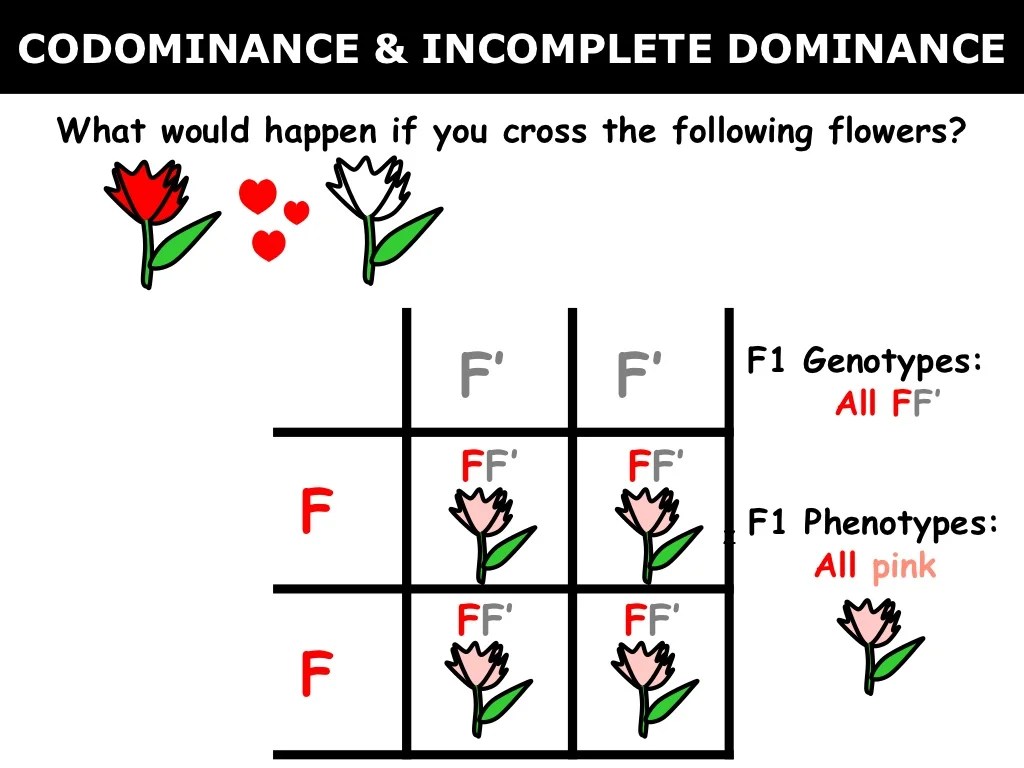Unveiling the intricacies of genetics, the practice codominance and incomplete dominance answer key unlocks the mysteries of inheritance patterns. Codominance, where both alleles of a gene are fully expressed, and incomplete dominance, where neither allele is dominant, present captivating genetic phenomena with far-reaching implications.
Delving into the depths of these concepts, we explore real-world examples, genetic mechanisms, and the significance of codominance and incomplete dominance in shaping genetic diversity and influencing fields such as medicine and agriculture.
Definition of Codominance and Incomplete Dominance
Codominance and incomplete dominance are genetic phenomena that involve the expression of alleles in an individual. Codominance occurs when both alleles of a gene are fully expressed in the phenotype, while incomplete dominance results in a phenotype that is intermediate between the two alleles.
Codominance, Practice codominance and incomplete dominance answer key
In codominance, neither allele is dominant over the other, and both are expressed equally in the phenotype. This results in a distinct and often visually recognizable pattern, such as the roan coat color in horses, which is a mixture of red and white hairs.
Incomplete Dominance
Incomplete dominance occurs when neither allele is fully dominant, and the phenotype is a blend of the two alleles. An example of incomplete dominance is the pink flower color in snapdragons, which results from the inheritance of one red allele and one white allele.
Examples of Codominance
Roan Coat Color in Horses
The roan coat color in horses is a classic example of codominance. The roan phenotype is caused by the inheritance of one allele for red hair and one allele for white hair. The resulting coat color is a mixture of red and white hairs, with the proportion of each color varying depending on the individual horse.
ABO Blood Type in Humans
The ABO blood type system in humans is another example of codominance. There are three alleles for the ABO blood type gene: A, B, and O. Individuals who inherit two A alleles have type A blood, those who inherit two B alleles have type B blood, and those who inherit one A allele and one B allele have type AB blood.
Individuals who inherit two O alleles have type O blood.
Examples of Incomplete Dominance: Practice Codominance And Incomplete Dominance Answer Key

Pink Flower Color in Snapdragons
The pink flower color in snapdragons is an example of incomplete dominance. The pink phenotype is caused by the inheritance of one red allele and one white allele. The resulting flower color is a blend of red and white, resulting in a pink hue.
Andalusian Chicken Feather Color
The Andalusian chicken breed exhibits incomplete dominance in its feather color. The blue Andalusian phenotype is caused by the inheritance of one black allele and one white allele. The resulting feather color is a mixture of black and white, giving the chickens a distinctive blue appearance.
Genetic Basis of Codominance and Incomplete Dominance
Codominance, Practice codominance and incomplete dominance answer key
Codominance is caused by the presence of two dominant alleles at a single gene locus. When both alleles are dominant, neither is able to suppress the expression of the other, resulting in the expression of both alleles in the phenotype.
Incomplete Dominance
Incomplete dominance is caused by the presence of two codominant alleles at a single gene locus. However, in this case, neither allele is fully dominant over the other, resulting in a phenotype that is a blend of the two alleles.
Significance of Codominance and Incomplete Dominance

Codominance, Practice codominance and incomplete dominance answer key
Codominance can have important ecological and evolutionary implications. For example, the roan coat color in horses may provide a camouflage advantage in certain habitats, as it breaks up the Artikel of the horse, making it more difficult for predators to spot.
Incomplete Dominance
Incomplete dominance can contribute to genetic diversity within a population. By allowing for the expression of both alleles, incomplete dominance can increase the range of phenotypic variation within a population, which can be beneficial in adapting to changing environmental conditions.
Applications of Codominance and Incomplete Dominance
Codominance, Practice codominance and incomplete dominance answer key
Codominance is used in forensic science to identify individuals based on their DNA. By analyzing the codominant alleles at specific gene loci, it is possible to determine the unique genetic profile of an individual.
Incomplete Dominance
Incomplete dominance is used in agriculture to create new varieties of crops with desired traits. For example, incomplete dominance has been used to develop wheat varieties with increased resistance to disease.
Question & Answer Hub
What is the key difference between codominance and incomplete dominance?
In codominance, both alleles are fully expressed, while in incomplete dominance, neither allele is dominant, resulting in an intermediate phenotype.
Can you provide an example of codominance in nature?
The ABO blood group system is a classic example of codominance, where alleles for type A and type B blood are both expressed, resulting in individuals with type AB blood.
How does incomplete dominance contribute to genetic diversity?
Incomplete dominance maintains genetic diversity by preventing the complete masking of recessive alleles, allowing for a wider range of phenotypic variations within a population.